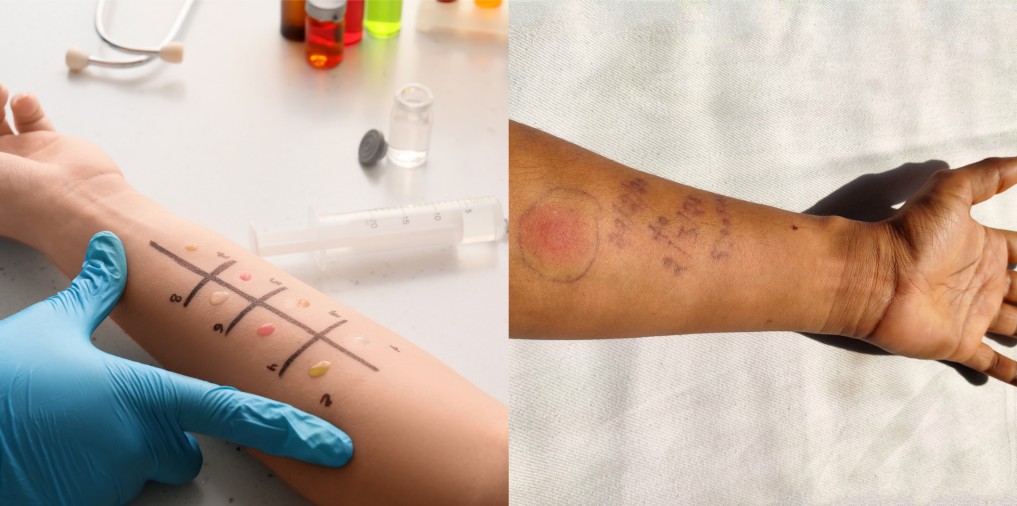
Patch testing is a preventive measure to identify potential sensitivity or allergic reactions to skincare products or ingredients.
By conducting a patch test, individuals can assess how their skin reacts to a product before applying it to larger body areas.
It’s important to note that many skin issues stem from using ingredients that trigger sensitivities in individual skin types.
Doing a patch test before using any new skincare product is always recommended, especially for young children or if you have sensitive or easily irritated skin. Natural ingredients, like herbs, oils, or essential oils, can cause sensitivity reactions.
Although patch testing may help identify a problem ingredient, it is sometimes foolproof. A patch test is not a guarantee against future skin sensitization.
Why Are Patch Test Necessary?
Patch tests are essential because they help you avoid possible adverse reactions to new ingredients or products. They benefit people with allergies, sensitive skin, or easily irritated skin. However, even if your skin is not sensitive, it is crucial to patch-test any new skincare product first. It is ideal to have it behind the ear or in the inner arm. We typically prefer the inner arm, which is easily covered with a bandage.
Procedure Tips:
- Ensure that the skin area for the test is thoroughly washed, dried, and clean.
- Apply a small amount of the test item (approximately the size of a dime) to the upper part of your inner arm, near the elbow.
- Cover the applied area with a bandage.
- Choose a time of day when you can keep the patch test undisturbed for at least 24 hours without exposure to water.
- Within twenty-four hours of application, look for any signs of sensitivity to the ingredients, such as redness, burning, itching, soreness, or other irritation.
- If you experience any irritation or reaction, promptly remove the bandage and cleanse the area with soap and water.
- The tested preparation is likely safe to use with no visible or sensory reactions. (Refer to the note below regarding Allergic contact dermatitis.)
If you’re conducting a patch test for herbs, blend a small quantity with water until it forms a paste. Apply this herbal paste for the patch test
If you’re conducting a patch test for pure essential oil, dilute it in a carrier oil at double the intended concentration, then apply as instructed earlier.

How to Test for a Facial Breakout?
Individuals with susceptible, easily irritated, or acne-prone facial skin should conduct a secondary patch test a few days after obtaining a clear result from the initial test behind the ear. Facial skin may respond differently to product ingredients.
This secondary patch test entails several days of observation. Apply a small amount (pea-sized) of the product to the area where it will be used (such as the forehead, cheek, or chin), and repeat this process daily for a week to monitor your skin’s reaction. Since repeated exposure to an “allergen” can exacerbate a reaction, proceeding slowly is preferable to risking widespread breakouts and inflammation on the entire face.
What to look for during the Patch Test?
Patch testing is a method for pinpointing substances that trigger contact dermatitis, a condition characterized by skin inflammation. Contact dermatitis manifests in two primary forms: irritant and allergic.
Irritant contact dermatitis: This reaction doesn’t involve the immune system. Its effects are most prominent immediately after removing the patch and typically diminish within the following day. While a substance causing an irritant reaction may exacerbate skin conditions like eczema, the reaction doesn’t intensify with repeated exposure.
Allergic contact dermatitis: This reaction stems from exposure to a specific substance known as an allergen and manifests solely in individuals allergic to that particular substance. It involves the immune system.

Note: As allergic reactions may take several days to manifest, especially for individuals prone to allergies, monitoring the patch area for a few days after its removal before proceeding with the product’s use is crucial. If you begin to feel or see any irritation from an allergic reaction, stop immediately if you start. Repeated exposure to the allergen can exacerbate the allergic response over time.
What to do if you have a Reaction
Cleanse the patch test area thoroughly and refrain from using the product on any other body part. If uncertainty persists regarding the test result’s conclusiveness, consider conducting another patch test in a different skin area after a week.
The subsequent phase involves pinpointing the specific ingredient responsible for the reaction. Keep a record of all potential suspects for future reference, aiming to narrow down the culprit eventually.
Remember that everyone’s skin is unique, and what works for one person may irritate another. Some people react to even very gentle natural ingredients.
Individuals with severe allergies, please be aware: If you experience severe anaphylactic reactions to ANY of the ingredients we use, we strongly advise against purchasing our products. While we maintain meticulous cleanliness in our formulation studio and ensure that all soaps and shampoos are cured in separate containers, we cannot guarantee that one soap did not come into contact with products of Natralee Botany products.
